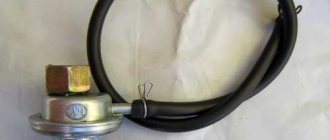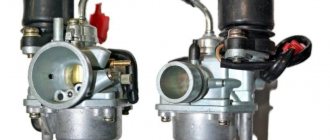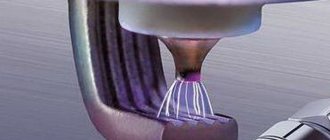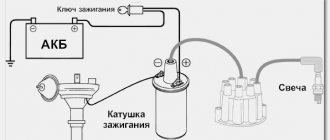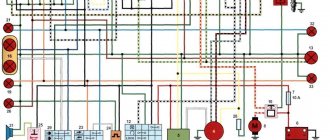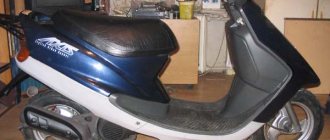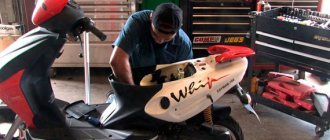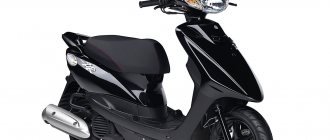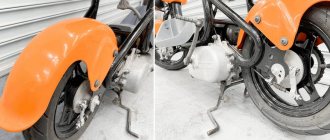The topic of gasoline for a scooter always contains questions. Everywhere you can find all sorts of contradictions and the tendency of scooterists to use different gasoline. The question is about filling 92 or 95 gasoline, which one is better for a scooter engine, which gasoline makes the scooter go faster, more powerful, and the most important point - does 95 gasoline harm the scooter engine?
There is no exact answer here for several reasons. Firstly, it is imperative to fill in high-quality gasoline at proven gas stations with a good reputation. Don’t think that if you have a scooter, then you can use all kinds of fresh water. This type of transport is very sensitive to fuel quality.
What kind of gasoline to pour into a Chinese four-stroke scooter
Now let's look at four-stroke models of Chinese scooters. In 80 percent of cases, the manufacturer recommends operating the device on 92 fuel, and only in some cases on 95. If possible, it is advisable to check this information for a specific model in the instruction manual. If the manual was not included, you can always find it on the Internet. As a last resort, look for a manual for another model, but with a similar engine. Fortunately, the entire Chinese motorcycle industry is similar copies with different names.
Recommendations for proper use of scooters
Scooters are fueled with AI-92 gasoline . It is not allowed to fill scooters with AI-98 gasoline, this will lead to overheating and burnout of the piston. As a last resort, you can fill it with AI-95 gasoline.
We also advise you not to refuel your scooter at unknown gas stations. This can result in low-quality gasoline and dirt entering the scooter’s fuel system, and premature clogging of the fuel filter and the entire fuel system.
The engine of a 2-stroke or 4-stroke scooter is very picky about the quality of oil. To the point that using low-quality oil can cause fatal damage to the engine in 1 day.
Motor oils that have proven themselves to be the best:
For 2-stroke engines:
Motul Scooter Expert 2T; Castrol Act Evo Xtra 2T; Liqui Moly scooter 2T.
For 4-stroke engines:
Motul Scooter Expert 4T; Liqui Moly scooter 4T.
In scooters with 2-stroke engines, oil is poured into a separate oil tank. During operation, in the engine, oil is mixed with gasoline automatically and is gradually consumed. One liter of oil for 2-stroke engines is usually enough for 600 - 800 km. for 50 cc engines, and for 500 - 600 km. for 90 - 125 cc engines, depending on driving style (the higher the speed, the higher the oil and gasoline consumption).
When the oil level in the oil tank drops to approximately 150 g. The warning light on the dashboard starts blinking (especially on rough roads). It is usually indicated by the inscription OIL or an oil can icon. If the oil level light in the oil tank is constantly on, you should immediately turn off the engine and fill the oil tank with oil.
Operating the scooter with the oil level light constantly on will lead to serious engine damage.
For standard scooters, it makes sense to fill only semi-synthetic oil. Cheap mineral oil, commonly used for lawn mowers, chainsaws and other garden equipment, should not be used at all. And it makes sense to use synthetic oil only on highly accelerated sports engines.
In 4-stroke scooter engines, oil is not consumed, but is located in the crankcase, and must be replaced (as in a car) after 3000 - 5000 km. mileage
The oil in the gearbox is changed once every one or two seasons. It is best to fill only synthetic oil for scooter transmissions. For example, Motul Gear Competition W75/140. For replacement you need about 100 ml. oil (more precisely, it is written on the gearbox cover of your scooter). You must fill in the exact volume indicated, using a syringe with a measuring scale.
air filter is usually a simple foam element. This is a very important part, which, if not promptly cleaned or replaced, usually quickly leads to serious engine damage. The frequency of cleaning or replacing the engine air filter depends on operating conditions. If you often drive on dusty roads (when dust swirls and flies behind you), then cleaning is required up to 1 time per week. If you drive mainly in the city on asphalt, then once every 2 - 3 months.
The scooter has a peculiar handling , which takes some time to get used to. Therefore, we advise you not to let unverified, inexperienced drivers and strangers “ride” the scooter. According to statistics, 90% of such cases end in a fall with injuries, or the scooter is broken or it can simply be stolen. You can only give a scooter a ride to those people whose driving skills you have no doubt about. If a person has ridden a motorcycle, this does not mean that he knows how to ride a scooter.
The scooter is quite simple in design, but, nevertheless, its repair requires special skills. Therefore, if you need to repair a scooter, it is better to contact a specialized service center or a trusted private technician.
Our company also deals with warranty and post-warranty repairs and maintenance of scooters.
Tel. service: +7 (915) 218-0820.
Types of gasoline scooters based on functionality and technical capabilities
Basically, the power of such a “toy” varies from 50 to 80 cubic meters - it depends on the age of the model.
Externally, scooters resemble greatly simplified copies of real mopeds and even motorcycles, but the bodies are never overloaded so that the child can ride comfortably.
For ease of use and maintenance, manufacturers add a variety of improvements that benefit both little owners and their parents - a good example would be a folding gasoline moped, which is convenient to store in almost any conditions. Another noticeable modification that is not installed on every model is the electric starter - it is necessary for easy starting of the device. Some models may come with branded equipment as a gift.
Owners of the vehicles in question often think about what kind of gasoline to pour into a Chinese scooter or a model from another manufacturer. Some buyers prefer 92 fuel, while others prefer 95. But you must remember that the choice of gasoline should be taken very responsibly. Just because you have a scooter and not a car at your disposal does not mean that the quality of the fuel does not matter. Therefore, visit only trustworthy gas stations and give preference to good fuel. This will extend the life and quality of the vehicle.
If you are interested in the question of what kind of 4-stroke gasoline to fill a Chinese-made scooter, keep in mind that most manufacturers of such models recommend that consumers give preference to grade 92 fuel. This is true for 80% of cases. Although sometimes it is acceptable to use 95 grade fuel. To clarify this issue, carefully study the vehicle's operating instructions before purchasing a new scooter.
If you have an Italian 4-stroke moped at your disposal, 95 gasoline is better suited for it, because their engines are forced and have a high compression ratio.
Next we should talk about what kind of 2-stroke gasoline to fill in a scooter, since such models are also widespread on the market. As a rule, 2-stroke moped engines have a low compression ratio, and therefore they “prefer” grade 92 fuel. In particular, models of the Honda brand can serve as examples of such vehicles. Manufacturers do not recommend pouring 95 gasoline into their tank, since it is not suitable for these types of engines. The same data can be found in the instructions for Yamaha and Suzuki scooters. However, their engines have a higher compression ratio, and therefore, theoretically, can run on 95 gasoline.
Regardless of what kind of moped you ride or where it was made, it is important to remember that such vehicles are very sensitive to fuel quality. Therefore, you should not experiment - strictly follow the instructions and do not try to pour fuel of dubious origin and characteristics into the tank. Otherwise, not only the power and speed of the moped will suffer, but also its durability. The engine can become damaged and fail prematurely, resulting in significant financial costs.
What fuel do you choose for your scooter? Share your experiences and impressions with other visitors to our site and learn their stories.
motoenc.ru
How to start a scooter
Despite the fact that all modern scooters are equipped with an electric starter, the use of its mechanical counterpart, the kickstarter , may be justified if there are doubts about the installed battery.
It may not be possible to start the engine the first time if, during storage or transportation on its side, all the fuel leaked from the fuel line into the tank, forming an air lock. Even full refueling will not help solve this problem, only repeated attempts to start.
Before you start the scooter, you should place it on the kickstand. After this, you need to turn on the ignition and, if the battery is well charged, try to start the engine by holding the brake handle and the electric start button for several seconds.
Test rides
As noted above, it takes very little time to get used to the scooter. Key points to consider on your first trips:
- acceleration control,
- correct braking
- and selection of cornering speed.
Simple rules for beginners
- You should not immediately go onto public roads and try to move at the speed of the flow.
- It is better to exchange the first ten kilometers on the odometer in safe, deserted roads or special areas.
- The speed for the first time should be limited to twenty kilometers per hour.
Why is fresh scooter gear oil necessary?
One of the most important components of a scooter can rightly be called the gearbox. It is responsible for timely reducing the speed of the driven shaft, thereby increasing torque. That is, it converts high speeds into fairly powerful, but low wheel speeds. This part consists of a number of rubbing elements (gears and bearings) that undergo enormous loads, and, as expected, they need good care. It is the transmission oil that provides such care.
It is an oil doped with various functional additives. The main function of transmission fluids can be called protective, as they protect the surface from wear, corrosion, seizing, etc. In addition, thanks to them, energy losses are reduced and heat removal from friction surfaces is ensured. Shock loads, vibrations and noise in gear drives are also significantly reduced.
What else shouldn't you do?
Another common mistake made by scooter riders is the desire to save money not by choosing a cheaper brand of gasoline, but by choosing a gas station. This approach also cannot be called correct, since even A-95 gasoline, purchased at a cheap and not entirely legal gas station, will not be able to provide good traction and acceleration dynamics.
Replacement algorithm
Motor oils come in mineral, synthetic and semi-synthetic bases.
There is no need to skimp on lubrication. The fluid level must always correspond to the operating level mark set by the manufacturer. If you do not add or change the lubricant, the piston group quickly becomes unusable or simply jams. This can lead to costly repairs. The lubricant is replaced after traveling 2-3 thousand kilometers.
To change the lubricant you will need:
- Socket or socket wrench (17 or 19).
- Funnel for filling.
- Rags.
- Thinner or a little gasoline.
- Container for processing.
Replacement algorithm:
- Warm up the engine by driving a couple of kilometers.
- Clean the filler and drain holes from dirt and deposits.
- Unscrew the dipstick and release the filler hole.
- Gradually unscrew the drain hole.
- Drain the liquid into a container, rinse the nut and filter. You can tilt the scooter slightly to completely empty the crankcase.
- Tighten the nut with the filter after the crankcase is completely empty.
- Fill in new oil through a funnel to the operating level (check by dipstick).
After replacement, you should periodically check the level and add oil if necessary.
Exhaust system
The exhaust system serves to remove exhaust gases from the engine cylinder, as well as reduce exhaust noise to the permitted level. The exhaust gases leaving the cylinder have a high temperature and are under excess pressure. If they immediately enter the atmosphere, their expansion will be accompanied by loud noise. A muffler is used to reduce it.
The “saxophone” muffler is the hallmark of Nexus scooters.
I want to tell you about my experience in repairing gas tanks. In my practice, there have already been several cases of gasoline leaking from tanks. Most often, this is poor quality welding of the tank drain neck and tank mounting points. In the case of the moped, it was a spot welding defect when the thin metal of the tank at the point where the lugs were attached gave a fatigue crack. I had to cut off the eye with a grinder, solder the tank and weld the eye in place. In general, I want to show you the process of soldering a tank, which is not as complicated as it seems and can be successfully repeated by you. Moreover, there are almost no costs, and in the end you save money equal to the cost of a new tank!
In general, it started with the client bringing a tank with a complaint about a gasoline leak. This is the tank:
Upon careful examination, it turned out that the crack had formed in the place where the tank drain neck was sealed, where the vacuum valve was screwed on. This is the place:
A ring crack is clearly visible at the junction of the neck and the wall of the tank.
To repair the tank using soldering I needed:
- Grinder with a grinding wheel (optional, you can just as well use sandpaper);
- Solder (in my case POS-60 in the form of a tube with a diameter of 1 mm with flux inside);
- Flux. I use LTI-120, “pickled acid” is also suitable, this is when zinc shavings are added to hydrochloric acid until the dissolution reaction stops. True, in this case, a thorough washing of the part is required to remove flux residues, otherwise there will be corrosion of the metal;
- Tool for soldering (powerful soldering iron, blowtorch or gas torch);
- Paint to give an aesthetic appearance to the repaired part and protect it from corrosion;
- The desire to do it all with your own hands!
So, let's go...
Using a grinder, we thoroughly clean the future soldering area from paint and other contaminants:
The soldering iron is practically not used, since the solder, when heated carefully, spreads well and wets the metal. We place the tank so that the soldering area is horizontal. This is necessary so that the molten solder does not flow down, but spreads evenly over the part.
Lubricate the soldering area with flux, look how it looks closer:
And we begin to heat the metal with a torch. You can use either a gas torch or a blowtorch, for example this one:
We heat not the metal of the tank, but the neck, from which heat is transferred to the walls of the tank. Otherwise, our flux will start to burn and we won’t get anything except smoked metal. When the steel heats up, we add a tube of solder, it will begin to melt and spread over the metal of the tank, gently wetting the soldering area. You see, nothing is smoked, and as a result, the soldering is smooth and neat. Like this:
Next, we wash off the flux with any solvent (alcohol, acetone, gasoline) and prepare the part for painting:
We can paint with any paint. I prefer nitro enamel in a can, like this one for example:
As a result, we got something like this:
Well, that's basically all there is to it. As you can see, there is no particular difficulty. This way you can repair any non-power metal structural elements of your two-wheeled friend! Good luck with the renovation!
The fuel valve is a structurally simple, but much-needed part for the correct operation of the scooter engine.
It should be immediately noted that for the most part, the fuel valve is non-separable and unregulated. If it fails, it simply needs to be replaced. Fortunately, it is inexpensive, and replacing it will only take a few minutes, even for an inexperienced scooter rider.
Location of the fuel valve under the tank
Not every scooter model is equipped with such valves; many engines with the tank located under the floor are equipped only with a fuel pump.
Operating principle of the fuel valve
So let's get to the point. Everyone knows that after starting the engine, a vacuum forms in the intake duct. Under the influence of negative pressure, the diaphragm compresses the spring supporting it, as a result of which a hole opens, through which, in fact, fuel enters the carburetor.
The vacuum from the intake manifold is transmitted to the tap through a separate rubber tube, the outlet of which goes under the membrane. Under the influence of vacuum, the membrane compresses the spring and opens the channel, after which fuel flows freely through the rubber tube from the fuel tank into the carburetor float chamber.
After stopping the engine, the vacuum disappears and the spring returns the diaphragm (valve) to its original position, the hole closes tightly and the fuel supply to the carburetor is completely stopped.
